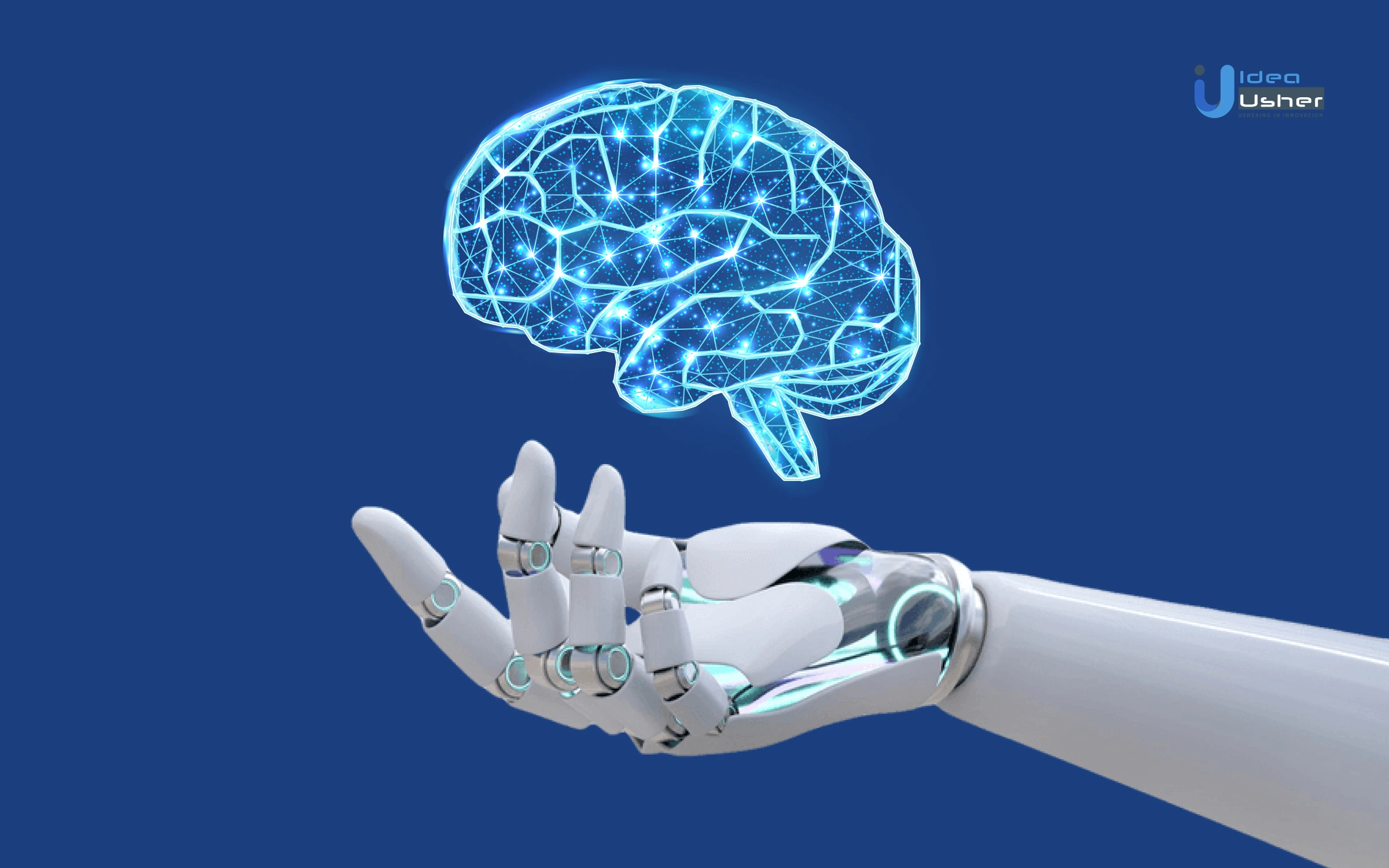When human beings first started envisioning AI, what they actually thought of was “automation.”
We simply wanted to leverage machinery and computational efficiency to help perform iterative manual work. Little did we know that soon, this technology will be one of the ultimate precursors to performing knowledge-based tasks.
Such tasks do not require fixed iterations. Performing them required “learning.” This gave birth to “Generative AI,” a new breed of artificial intelligence that can now do everything we humans can but with better efficiency and superiority.
Here are some interesting statistics about the technology:
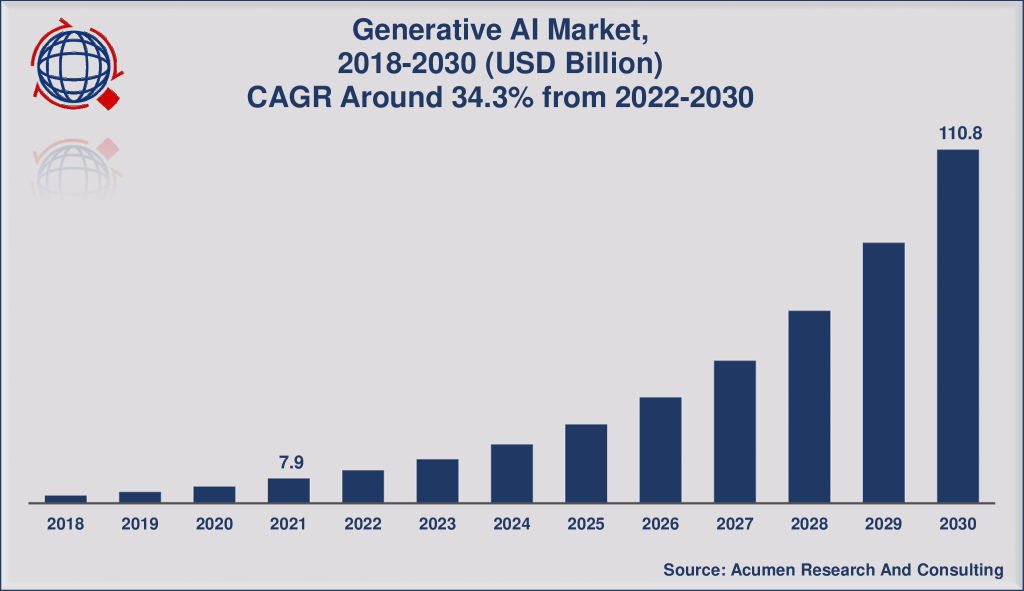
- The Global Generative AI market was valued at $7.9B in 2021 and is expected to grow to $110.8B by 2030, with a CAGR of 34.3% from 2022 to 2030.
- Gartner foretells that by 2025, Generative AI will account for 10% of all data produced.
- Four startups recently raised substantial sums at high valuations: Jasper, a copywriter assistant, raised $125 million at a $1.5 billion valuation; Hugging Face raised $100 million at $2 billion; Stability AI received $101 million at $1 billion; and Inflection AI closed $225 million at a post-money valuation of $1 billion. OpenAI, meanwhile, secured $1 billion from Microsoft in 2019, valuing the company at $25 billion.
- Popular Generative AI tools like MidJourney, Jasper.ai, and ChatGPT, are completely disrupting creative task-performing spaces, recording millions of active users daily.
In this blog, we will explore the various facets of Generative AI and discuss how this disruptive technology can radicalize future digitally performable tasks.
What is Generative AI?
Generative AI, also known as generative artificial intelligence, is a field of AI that focuses on creating new content through machine learning algorithms. Based on that learning, these systems are trained to understand patterns and rules in data and then generate unique outputs, such as text, images, audio, or video. This type of AI has the ability to mimic human creativity and generate outputs that are diverse and never seen before, making it an exciting area of research and development.
Also, Read – AI as a service.
Building Blocks of Generative AI
It mainly consists of three major elements:
1. GANs
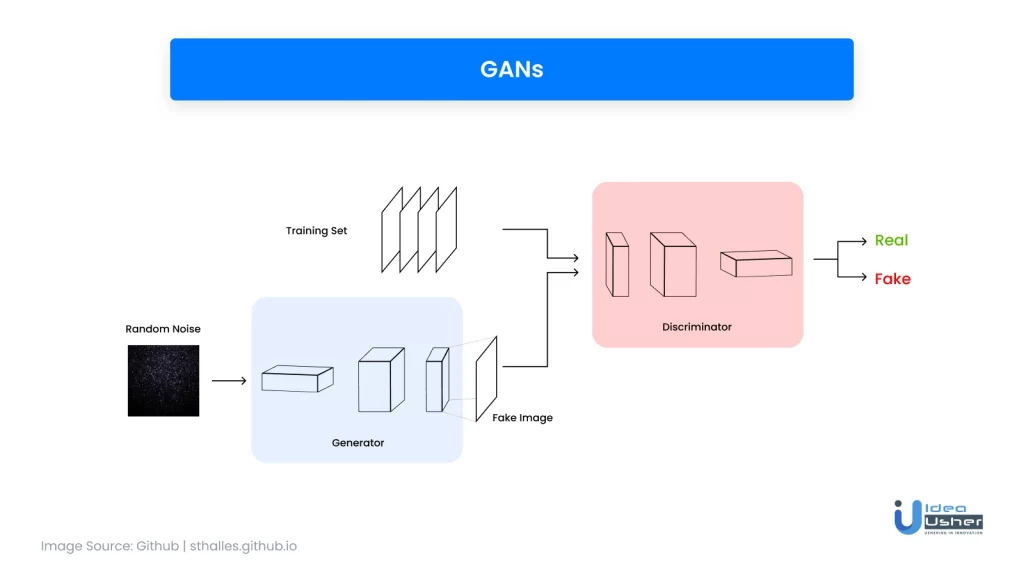
Generative Adversarial Networks (GANs) were introduced in 2014 by Jan Goodfellow and his team at the University of Montreal in the paper “Generative Adversarial Networks.” Since its inception, GANs have become a highly sought-after generative AI model due to its numerous research and practical applications.
GANs consist of two sub-models: a generator and a discriminator. The generator, a neural network, creates fake samples from a random input, while the discriminator, another neural network, determines if the given sample is real or fake. The discriminator acts as a binary classifier that returns a probability score, with a score closer to 0 indicating a fake sample and a score closer to 1 indicating a real sample.
Both the generator and discriminator are often implemented using Convolutional Neural Networks (CNNs) when working with images. The adversarial aspect of GANs is based on a game-theoretic scenario where the generator competes against the discriminator. The generator creates fake samples while the discriminator tries to distinguish between real and fake samples. The network that fails is updated, while the winning network remains unchanged.
A GAN is considered successful when the generator creates a sample so convincing that it can fool both the discriminator and humans. This keeps continuing as the discriminator is updated to become better, and the cycle repeats.
2. Transformers
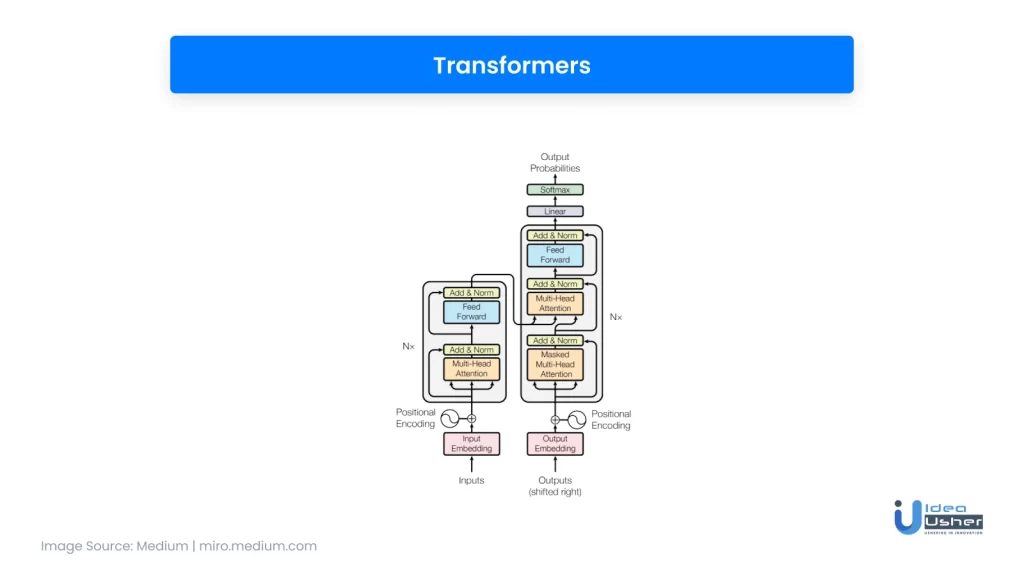
Transformers are deep neural networks that excel in Natural Language Processing (NLP) tasks by tracking relationships in sequential data, such as the words in a sentence. Well-known examples of transformers include GPT-3 and LaMDA.
- GPT-3 is a third-generation language model developed by OpenAI, a San Francisco-based artificial intelligence laboratory. It is capable of generating text that resembles human writing, including poetry, emails, and jokes.
- LaMDA, or Language Model for Dialogue Applications, is a series of conversational neural language models created by Google, based on their open-source neural network architecture for natural language understanding.
These networks typically perform semi-supervised learning, where they are pre-trained on a large unlabeled dataset in an unsupervised manner, and then fine-tuned through supervised training to improve performance. They consist of an encoder and decoder, both consisting of multiple encoder blocks.
The encoder processes the input sequence and extracts features, converting them into vectors, which are then passed to the decoder. The decoder receives the encoder outputs, derives context, and generates the output sequence.
Transformers only use sequence-to-sequence learning, where they predict the next word in the output sequence by iterating through encoder layers. They utilize attention mechanisms, or self-attention, to detect relationships between distant data elements in a series and provide context for each word in the input sequence. Additionally, transformers can process multiple sequences in parallel, speeding up the training phase.
3. VAEs
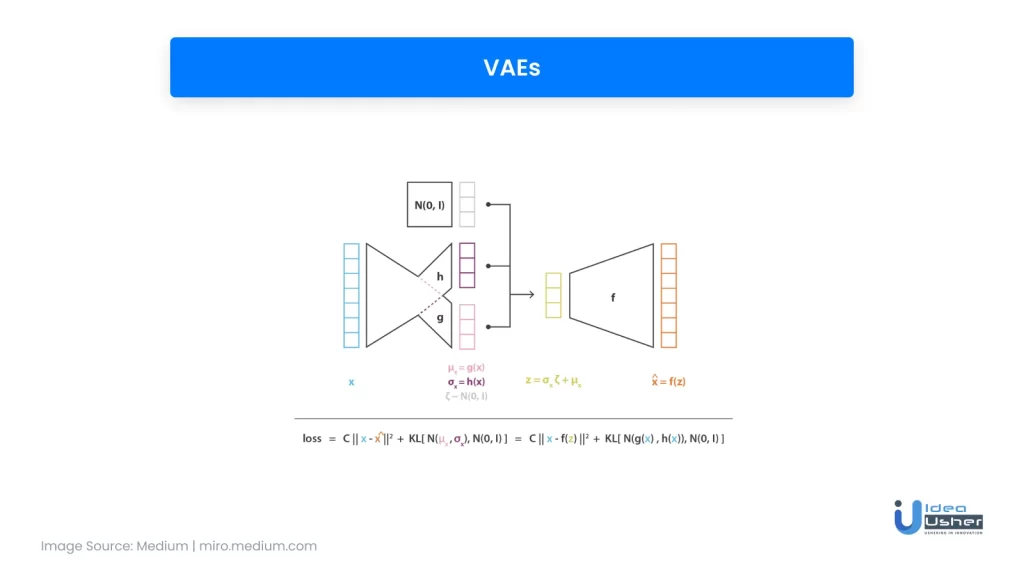
Variational Autoencoders (VAEs) are a type of machine learning model that focuses on generating new data samples similar to the input data. This is achieved by combining the traditional autoencoder architecture with the concept of variational inference.
VAEs consists of an encoder network and a decoder network, which together learn a compact representation of the input data. The encoder network maps the input data to a latent space, or hidden representation, while the decoder network maps the latent space back to the original input data.
What sets VAEs apart from traditional autoencoders is the probabilistic formulation of the encoding process. The encoder network outputs a mean and variance, which together define a Gaussian distribution over the latent space. This allows for a more flexible and expressive representation of the input data, and enables the generation of new samples by sampling from the latent space and passing it through the decoder network.
VAEs have been used in a range of applications, including image synthesis, text generation, and anomaly detection. Due to their ability to learn rich representations, they have become a widely used tool in the field of generative models.
Major Applications of Generative AI
There’s literally no bar to the tasks that can be performed using this specialized intelligence technology, although its prime utilization involves:
1. Photo Generation
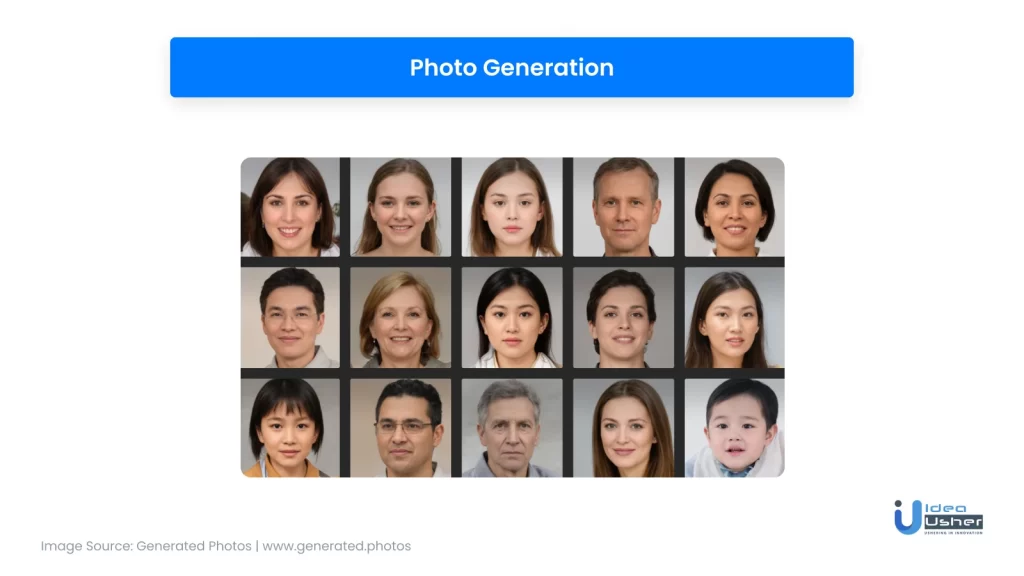
AI-based applications and software can generate new, realistic photographs based on existing data, such as photographs of human faces, objects, and scenes. This involves familiarizing a neural network on an extensive dataset of existing photographs. The network then uses this training data to generate new photographs that resemble the source data.
The resulting images are often very realistic and can be used for various purposes, such as creating digital avatars, filling in missing information in a photo, or improving the quality of images that are too small or blurry.
DALL-E 2, MidJourney, DeepDream and Pix2Pix, are some of the prime AI-based image-to-image photo generation applications.
2. Image Conversion

MidJourney and DALL-E 2 are dominating in this domain, with the latter witnessing a 10001% growth last year, and a volume of 948k per month. Another popular AI image conversion app that surfaced parallely is Lensa.ai, boasting a 1 million+ active user base and a whopping 16.22 million revenue collection as of December 2022.
Generative AI can convert one image into another, offering new ways to enhance, transform, and manipulate existing images. For example, converting black and white photos to color involves training a neural network on a large dataset of black and white and color photos. The network then uses this training data to generate new, color versions of black-and-white photos.
Another example is converting day photos to night photos, which involves transforming the lighting and color information of an image to resemble a night-time scene. Such image conversion become especially useful for enhancing photos taken under poor lighting conditions or transforming existing images to create new and unique scenes.
AI can also convert photos into artistic paintings. This process involves training a neural network on a large dataset of photos and paintings and using this training data to generate new images that resemble paintings. The resulting images often have a unique and creative aesthetic that can be used for various purposes, such as creating digital art, enhancing the visual appeal of existing photos, or creating new images for use in media and entertainment.
3. Film Restoration
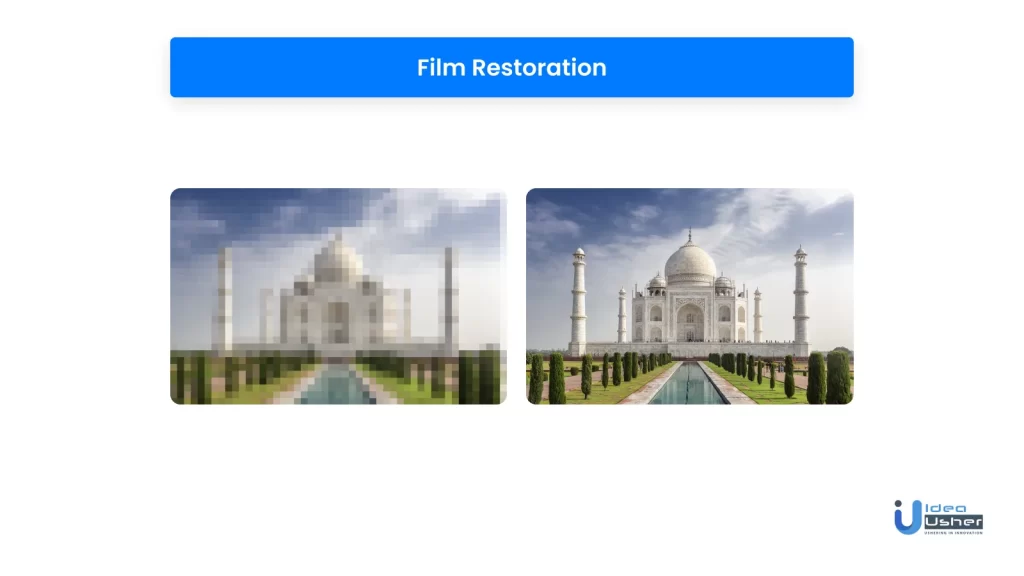
Film restoration can be complicated and time-consuming, but with generative AI, the process can be made much faster and more efficient. The technology can upgrade the film’s resolution to 4K or higher, creating a much clearer and more vibrant picture.
Additionally, it can increase the frame rate of the film, creating smoother motion and reducing the appearance of flicker or stutter. This can bring new life to old films and preserve the legacy of cinema for future generations to enjoy.
DAMINAT, VIVA, and AVCLabs Video Enhancer are some of the popularly used film restoration tools that are used for semi-proffesional as well as professional grade film restoration tasks reducing like high levels of dirt, scratches, and flickering
4. Semantic Image-to-Photo Translation
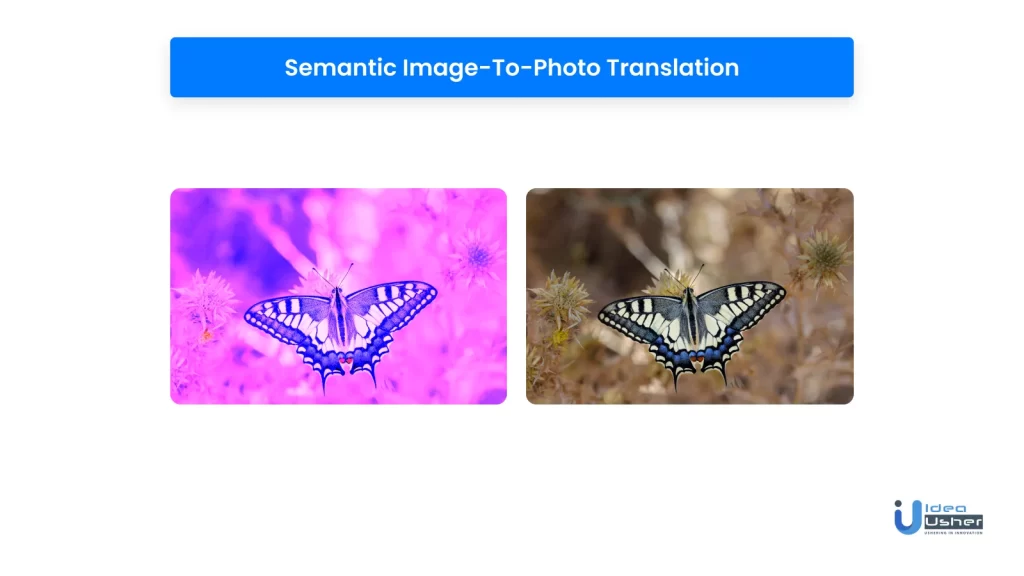
Generative AI can also transform abstract or stylized depictions of objects or scenes into photorealistic images. This technology can take a simple sketch or a stylized image and produce a high-quality, highly detailed, and lifelike representation of that object or scene.
The power of this technology lies in its ability to capture the essence of an image, even in a simplified form, and then generate a photorealistic representation of it. This can be useful in various applications, from creating visual designs for websites or advertisements to generating 3D models for video games or virtual reality experiences.
GANs are mostly used over VAEs for best quality semantic image-to-photo optimization. The following research paper here demonstrates how dynamically developed GANs can produce high quality results compared to utilization of baseline models.
Checkout this repository for more information.
5. Face Frontal View Generation
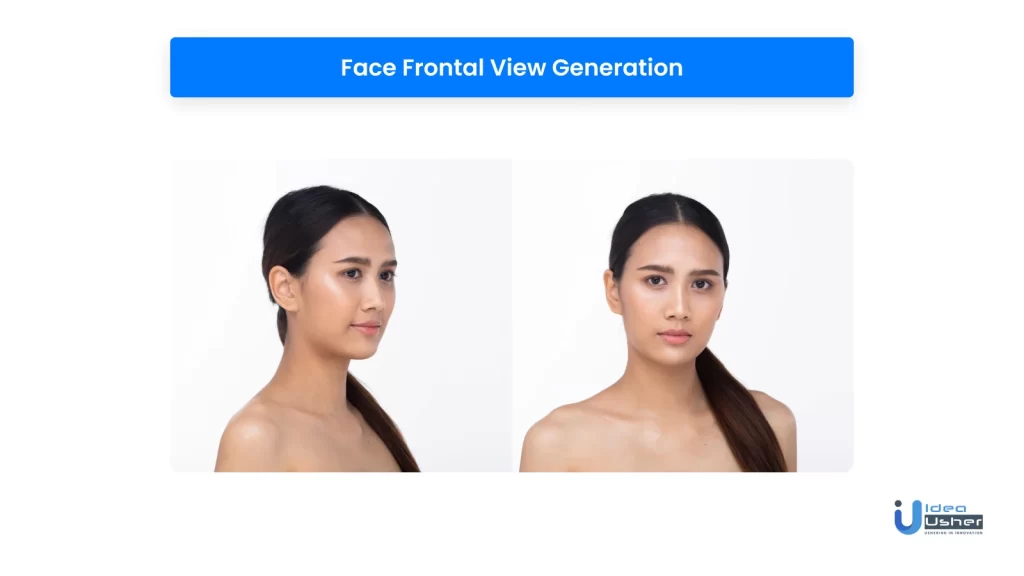
Using algorithmic learning, Generative AI systems can generate a front view of any photo, even if the original photo is not an ideal shot, such as a profile view or an angled view.
This is particularly useful for facial recognition and verification systems, where a frontal view of an individual’s face is required for accurate identification. It can also be useful in other applications, such as social media, where individuals may want a profile photo showing their face in a frontal view.
6. Photos to Emojis
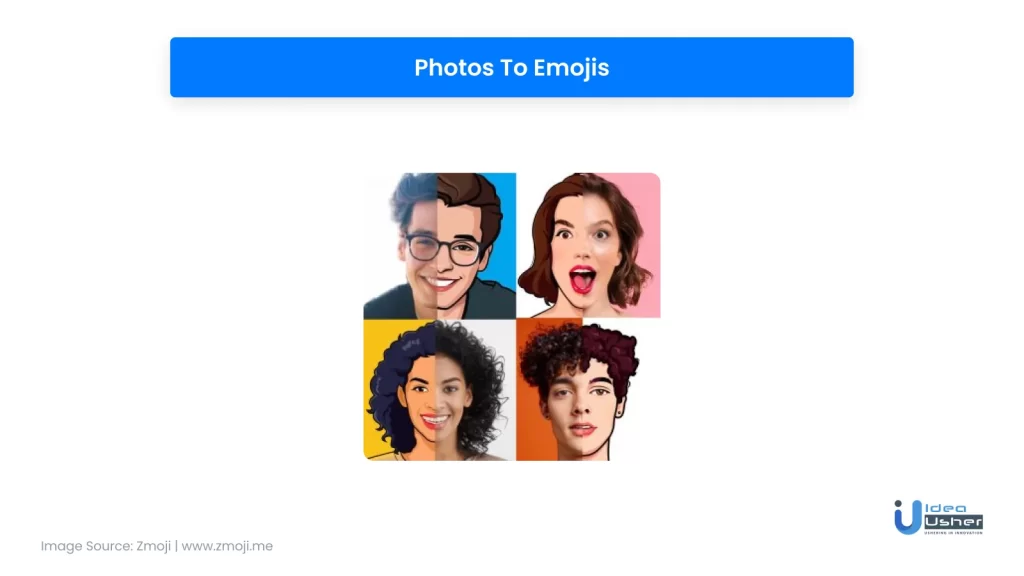
This application of Generative AI leverages deep learning algorithms to transform real-world photos into small, stylized, and animated representations. The process involves capturing the key features and emotions of the input photo and transforming them into a simplified and expressive emoji representation. Such allows for a fun and creative way of expressing emotions, moods, and sentiments through visual symbols.
Apple’s Memoji, Google’s Algo and Image to Cartoon are examples of some tools that extensively utilize AI and machine learning to convert photos to images.
7. Face Aging Detection
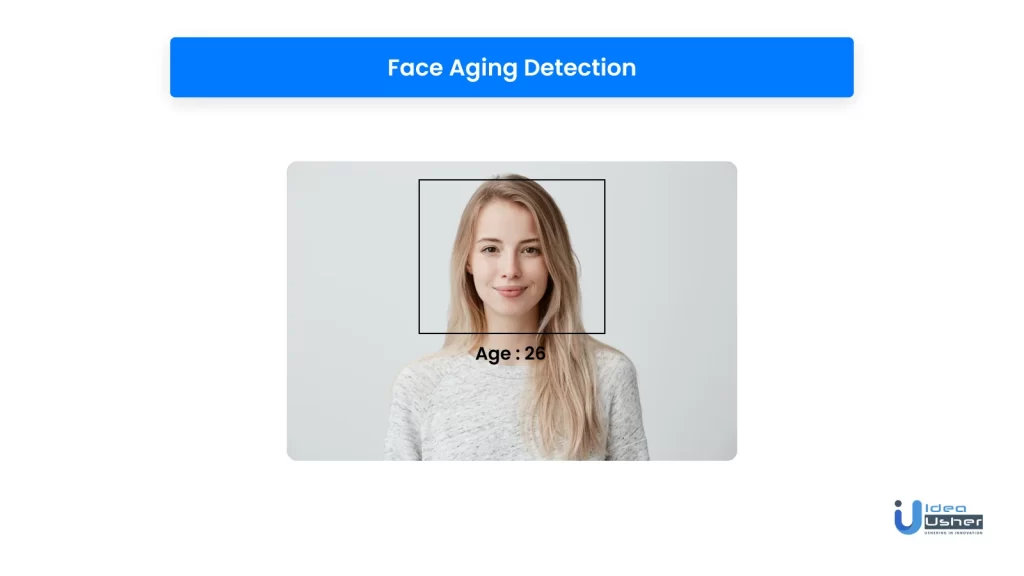
Generative AI models can be trained on deep learning algorithms to use large datasets of face images for detecting face aging to learn how facial features change over time. These models analyze various factors, including wrinkles, skin texture, hairstyle, and other facial features, to create realistic aging simulations.
Face aging has a wide range of applications, such as in criminal investigations, where age progression is used to predict what a missing person might look like after a certain number of years. It is also used in demographic and marketing research, where age progression can help businesses better understand the aging process and predict changes in consumer behavior as people grow older.
8. Text Generation and Chatbots
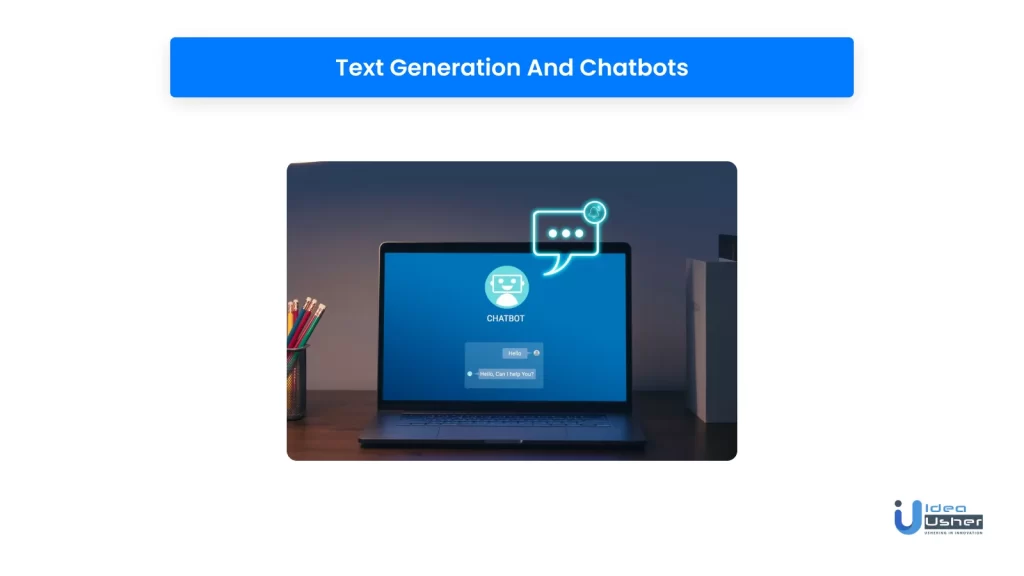
Generative AI can also produce written content and participate in user conversations. Utilizing models trained on massive amounts of text data, AI can generate large volumes of creative/critical texts. They can also be used as chatbots to generate human-like responses in a conversational setting.
ChatGPT, LaMDA, and ChatSonic are some of the widely used AI chatbots. Bloom is another great chatbot that supports generating text in 46 natural languages and 13 programming languages. It has 70 layers and 112 attention heads per layer, with a hidden dimensionality of 14336 and a 2048 token sequence length.
Industry-wise Implementation of Generative AI

Automated Software Engineering
Automated software engineering using AI-powered tools is revolutionizing the way digital solutions are created. With generative AI driving the field forward, companies like GitHub’s CoPilot and Debuild are leading the way.
These tools streamline the coding process, allowing for faster and more cost-effective development of digital solutions. AI-powered automated software engineering has the potential to generate unlimited engineering designs, test cases, and test automation, ultimately reducing costs and increasing speed and effectiveness.
Content creation and management
Generative AI technology is revolutionizing content creation and management, making it easier for businesses to produce high-quality content quickly and efficiently. Companies like Omneky, Grammarly, DeepL, and Hypotenuse use AI algorithms to optimize digital ads, generate optimized copy for websites and apps, and create content for marketing pitches.
The technology is especially useful for creating better-performing digital ads, reducing research time, and generating persuasive copy and targeted messaging. Using Generative AI technology, businesses can augment human creativity and create high-quality content in less time than manual methods.
Marketing and customer experience
Businesses are utilizing AI to enhance the personalization and tailored experience for customers in marketing and customer experience. AI-powered autonomous content generation can construct high-quality content efficiently and quickly, such as product descriptions, ad captions, blog articles, and more.
Companies are leveraging AI technology to simplify the development of virtual assistants, generate marketing materials, answer complex customer questions, and increase conversion rates. Some of the innovative startups in this space include Kore.ai, Copy.ai, Jasper, Andi, and Mongoose Media, with the latter seeing a 166% increase in web traffic and a 400% improvement in efficiency in a matter of two months.
Healthcare
The healthcare industry has seen a significant impact from the integration of generative AI. The technology has revolutionized how physicians diagnose patients and has become a powerful tool in drug development, enabling quicker time-to-market treatments and reducing costs.
AI is also being used to create more accurate cancer diagnosis algorithms, develop deep learning algorithms for diagnostically challenging tasks, and assist with day-to-day medical tasks such as wellness checks.
Ordaos Bio uses AI to uncover patterns in drug discovery, while Paige AI develops generative models to assist with cancer diagnostics. Ansible Health uses its ChatGPT program for functions that would otherwise be difficult for humans, while ABSI is transforming the field of antibody therapeutics through its Integrated Drug Creation platform, which predicts the specificity, structure, and binding energy of antibodies.
Incorporating additional data such as vocal tone, body language, and facial expressions, AI technology is also becoming valuable in determining patients’ conditions, leading to quicker and more accurate diagnoses for medical professionals.
Product Design and Development
Another domain that significantly gained from AI technology is product development. It is helping with product innovation by generating new ideas and providing automated data analysis for better customer understanding.
AI-powered product engineering allows virtual simulations, solves complex problems more quickly, and improves design accuracy.
Companies like UIzard, Ideeza, and Neural Concept offer platforms for optimizing product engineering with AI-powered design and prototyping tools, drug development optimization, and enhanced R&D cycles.
Advantages of Generative AI
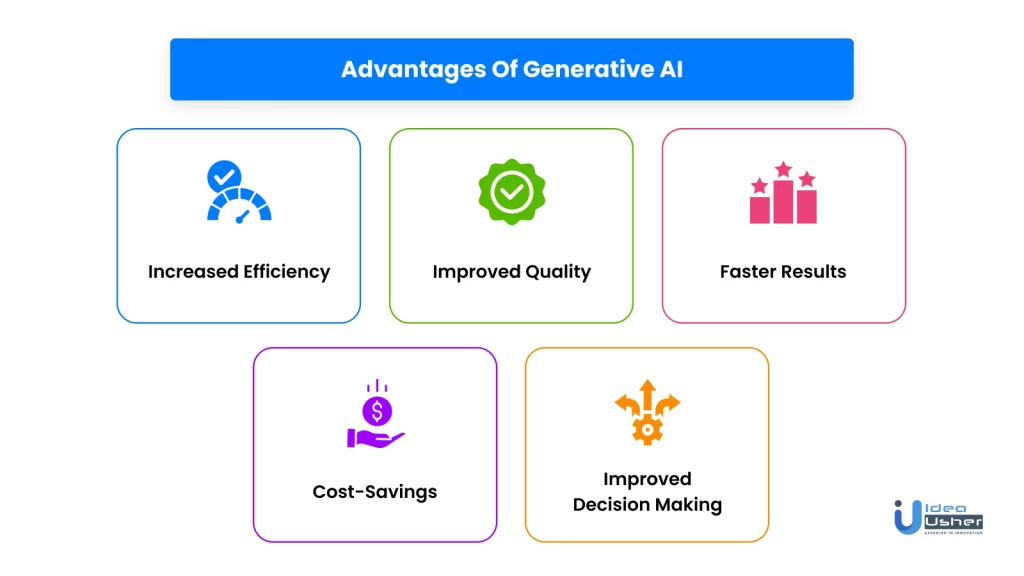
1. Increased Efficiency
The technology can be employed to automate labor-intensive tasks, ultimately increasing efficiency and saving time and money. This technology can be utilized to generate images and videos quickly and accurately, which can be beneficial for marketing campaigns and other projects.
2. Improved Quality
It can also be used to produce higher-quality images, videos, and texts that are more accurate and relevant than those created manually. It can help create visuals that are more visually appealing and texts that are more precise and pertinent. Additionally, generative AI can help ensure that generated content is optimized for search engine optimization (SEO).
3. Faster Results
Utilizing Generative AI technology enables organizations to obtain quicker outcomes than they could by manually carrying out tasks. For instance, it can be utilized to produce visuals and videos faster than a human could do in the same amount of time. This can assist organizations in completing their projects faster and more productively.
4. Cost-Savings
AI, in general, has the potential to drastically reduce costs by automating processes, eliminating manual labor, and streamlining operations. By leveraging machine learning algorithms, Generative AI facilitates the generation of high-quality content, reduces the need for manual data entry, and optimizes processes to save time and money.
5. Improved Decision Making
Last but not least, the technology helps businesses to make more informed decisions. By using generative AI, businesses can create data that can be used to evaluate different choices. For instance, this AI-generated data can be used to assess marketing strategies or product development options. Access to this data can enable businesses to make smarter decisions that are more likely to lead to success.
What does the future hold for Generative AI?
With the pace at which technology is witnessing development, the future of Generative AI is looking very promising and holds endless possibilities. The technology has advanced significantly over the past few years and continues to evolve rapidly.
In the future, the tech can play a major role in transforming many industries, such as healthcare, finance, and creative arts. With the ability to generate new and unique content,
It can also revolutionize the marketing and advertising sector.
Moreover, with better advancements in Natural Language Processing (NLP), Generative AI will improve and become more sophisticated in generating human-like responses and conversations. With continued research, investment, and critical consideration of its relative concerns, Generative AI will radically transform technological operations and assistive automation.
Conclusion
With the right approach, generative AI has the potential to bring about a future of increased efficiency, creativity, and discovery. The only way forward to this is informed utilization. Ensuring that AI is developed and used ethically and responsibly will be critical to its success and widespread adoption. With all said and done, this is certainly the golden era for businesses and individuals who seek to leverage AI to build upon and generate substantial income.
Get in touch with us now!
Build Better Solutions With Idea Usher
Professionals
Projects
Contact Idea Usher at [email protected]
Or reach out at: (+1)732 962 4560, (+91)859 140 7140
FAQs
Q. What is generative AI?
A. Generative AI refers to algorithms capable of generating novel content, ranging from audio, code, images, text, simulations, and videos. Such advancements in the field of AI have the potential to revolutionize the way we create content.
Q. How is generative AI used?
A. One prime application of generative AI is to improve the accuracy of deep learning algorithms by artificially augmenting a data set with additional, unseen data similar to the original data in structure and content. This helps ensure that the machine learning models are trained on high-quality data, leading to better results. There are several other applications of the technology.
Q. What is the potential of generative AI?
A. Generative AI has a vast potential that can impact all areas of life. This technology can generate new and unique pieces of art, music, and literature, allowing for limitless creative expression. It can also be used in product design, allowing companies to bring new products to market faster. The technology can also create large amounts of written and visual content, such as news articles, videos, and images, with speed and efficiency. Additionally, it can be used to identify solutions to complex problems and personalize products and services based on individual preferences and behaviors, providing a more tailored user experience.
Q. What are the learning types used for generative AI?
A. Generative AI mainly follows two learning models: unsupervised and supervised learning. The AI model is trained without specific guidelines or labels in unsupervised learning. In contrast, in supervised learning, the model is trained using labeled data sets that provide instructions for the desired output.
Q. What is the problem with generative AI?
A. Generative AI has several limitations and challenges. Such as
- the potential for biased outputs due to the AI models learning from biased data,
- quality control issues with generated content not meeting desired standards,
- a lack of clear regulations and ethical guidelines around its use,
- the potential for misuse, such as creating fake news or spreading misinformation, and,
- limitations in creativity where AI models may struggle to produce truly original content.
